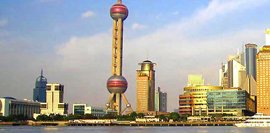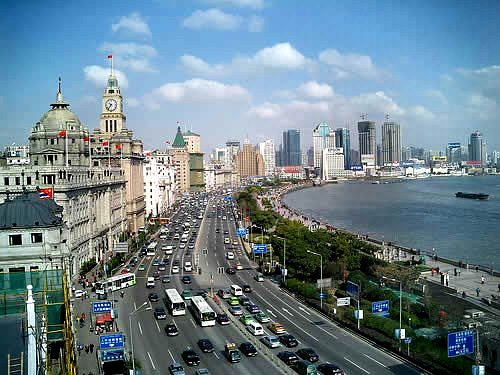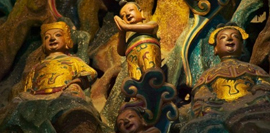"Shikumen", meaning "stone gate" , is a special old form of residence in Shanghai. In many ways, it is indeed a gateway to the fascinating history of this largest coastal city of China. In the middle of the 19th century, the uprising of the "Taiping Heavenly Kingdom" forced a large number of residents from Shanghai and its neighbouring Jiangsu and Zhejiang provinces to take refuge in the city's foreign concessions. To meet the needs of the rapidly increasing population, "Shikumen" houses were built in the foreign concessions on an unprecedented scale.
A typical "Shikumen" house is built along narrow alleys (or "long-tangs") and features a stone gate framing a black wooden front door that leads into a small enclosed courtyard. This unique architectural setting provided residents with a feeling of security in a turbulent era, and as most of them were developed by foreign companies, "Shikumen" houses had gradually become a symbol  of East meeting West in Shanghai.
of East meeting West in Shanghai.
History of Shikumen
In the early 1900s, the Shikumen lanes were considered among the younger generation as the ultimate examples of dilapidated, crowded and wretched urban living. Luckily for the generations to follow, a few literary masterpieces were written by writers infatuated with the lane's architecture which introduced people to the hidden beauty of Shikumen.
In the Shanghai dialect, wrapping or bundling is called 'hooping', giving rise to phrases like 'hooping a bucket', so doors 'hooped' by stone bars were called Stoned-hooped doors, and later the name changed to Shikumen. Generally, the Shikumen-style buildings have long bars of stones as doorframes and burly wooden planks as doors, each fixed with a huge bronze ring.
The origin of Shikumen buildings can be traced back to the 1860s. In 1860, the Taiping Rebels led by Li Xiucheng advanced east, conquering a string of important towns in eastern China, causing an influx of refugees from southern Jiangsu and northern Zhejiang into the foreign settlements in Shanghai. To accommodate this inflax of refugees, local merchants were encouraged to invest in housing for these people. To use the limited land more efficiently, the houses built were in most cases rows of Shikumen-style buildings.
These buildings reflect a mix of Chinese and foreign styles of architecture. Shikumen-style buildings have certain elements of the west, but most of the design and layout is in line with that of the "Jiangnan" area of eastern China. Behind the Shikumen door is a courtyard, and further inside is a living room, locally known as a parlour, and then there is the back courtyard, kitchen and back door. To the sides of the courtyard and the parlour are the right and left wing rooms. The layout of the second storey is similar to the one below, but above the kitchen is the garret, above which is a flat roof. The typical buildings of the Shikumen style can be seen within Xingrenli - an area of 1.33 square kilometers defined by the east side of Henanzhong Road, Ningbo Road and Beijing Road; and also within Dunrenli, Mianyangli and Jixiangli, all near the Xinmatou Street close to Zhongshannan Road.
After the early 1900s, Shanghai's households became smaller in size and the residents' living patterns underwent major changes. The structure and layout of the Shikumen-style houses also changed as a result. Smaller units, without wing rooms and suitable for small households, appeared, together with somewhat larger units with one parlour and one wing room. These new two-or-three-storey Shikumen houses were separated by lanes four meters wide. Humble "Tingzijian" rooms were found at the turn of the staircases while verandahs were added to the facades. After the 1920s, sewerage systems were installed. Typical examples of such Shikumen buildings are the Jingan Villa on Nanjingxi Road, and the Daluxin Villa on Shanyin Road.
After the 1930s, Shanghai faced a housing shortage, so the owners of Shikumen-style buildings rented out some of the rooms. Since then most Shikumen-style buildings have had their original layouts altered and became mansions housing more than one family.
Shikumen-style houses formed the basis of the "Li Long" (lane) community where private spheres and public spaces overlapped. In this community, everyone knew everyone else's business. As the density of the community rose, some family activities were often moved to public spaces.
At their peak, the Shikumen-style neighbourhoods numbered more than 9000 in Shanghai and took up 60 per cent of the total housing space of the city. The Shikumen style, which has survived for more than a century, is however no longer suitable for modern urban living. Since the 1990s, Shanghai began a new wave of renovation and development, demolishing many Shikumen-style buildings. It was only when more and more of these houses were replaced by skyscrapers that people began to realize such monuments of Shanghai's past deserve to be preserved.






